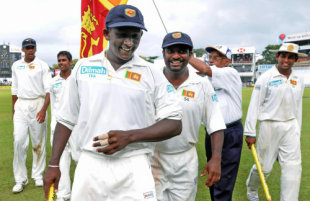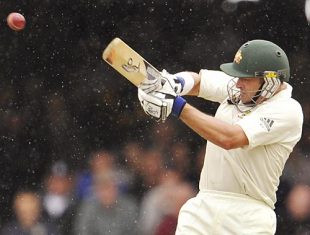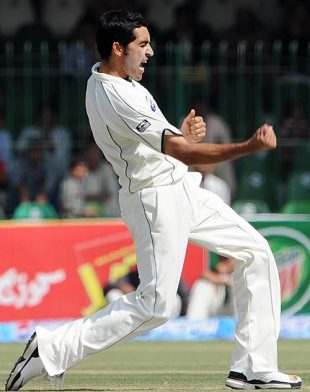In the cricket match between the villagers of Champaner and the local British garrison that climaxes the sprawling Bollywood epic
. The villagers' captain Bhuvan, played by a bare-chested Aamir Khan, calls to the bowling crease his friend Goli, whose self-taught method is to bowl from a standing start after a dozen anti-clockwise rotations of his arm. At once there is consternation. "He should not be able to bowl like that," the beastly British cad Captain Russell complains to the umpires. "It is improper."
The umpires look like acquiescing until the cad's comely sister Elizabeth intervenes. The memsahib, inevitably in love with Aamir and better versed in cricket than some ICC referees, avers that the Laws are not so prescriptive where bowling actions are concerned. The umpires nod sagely, and the game proceeds, although the cad and his fellow bounders continue griping. "Damn ridiculous," complains one defeated batsman. "Dangerous too."
In its majestic, longer-than-a-Twenty20-game sweep, Lagaan has a lot of fun with cricket past and present: the English, for instance, perpetrate the first "Mankad", while an Indian pioneers the scoop over the keeper. But the Goli sequence is perhaps the most obvious take on a contemporary theme, and repays some consideration as Test cricket's greatest wicket-taker nears the end of his extraordinary career, having hardly bowled a legal delivery - at least as far as many Australians are concerned.
No English rose was ever going to smooth over Murali's action with honeyed words. Allan Border faced his first few deliveries in Test cricket, took the tangle of arms and bulging eyes as accessories to legspin, and watched in bemusement as they turned massively in the opposite direction. Even before the matter of his legality, Murali stretched the game's lexicon to breaking point, being an offbreak bowler whose rotations were more a function of a rubbery wrist than dirty great Gibbsesque digits. Offspin is cricket's rubbish skill - something easy to do in a mediocre fashion, and the eternal preserve of the untalented. John Howard bowled offspin - as indeed do I, and utter filth it is too.
That said, offspin is supremely difficult to do excellently. The game's annals contain perhaps fewer great bowlers of offbreaks than legbreaks. After Trumble, Laker, Tayfield and Prasanna, who? Murali, then, shone a bland skill through the prism of his wrist into a rainbow of possibilities. He made it turn, he made it bounce. He made it unintelligible, scrambling the seam, so that the ball approached in a cloud of white noise. Most renownedly, he and Saqlain Mushtaq fostered the doosra, the googly's evil twin, the finger-spinner's revenge.
As a result of a congenital deformity, of course, Murali also bowled with an arm that was not straight - and bowling is traditionally a straight-arm exercise. Oddly enough, nobody knows why. The best Rowland Bowen can do in his finest of cricket histories is to advise: "At some unknown stage, the idea took root that 'cricket' bowling involved a straight arm." We can point at least a little more precisely to when, in the sense that it probably wasn't until the 1890s that the Law was strictly enforced, when MCC, and its chief agent, the Australian umpire Jim Phillips, imposed a fatwa on "chuckers" in English county cricket.
Murali could still be within the Law, providing he did not straighten his arm, and whether he did or didn't became one of the most intractable controversies in cricket history. The answer was pursued with fantastic zeal, by combinations of naked eye and lay opinion on one side, and medical and technological analysis on the other. And the answer was: it depends. Yes, Murali's arm bent, but no more, and in some instances less, than the arms of every bowler. This was not an answer anyone had really expected. Science was meant to provide answers, not to furnish further questions. But it left lawmakers with a choice, between a zero-tolerance approach based on assertion, or a scheme with a 15-degree shade of ambiguity derived from biomechanics. They went the latter route - and the five years since seem to have proven them right.
It is worth saying that while the vast majority of complainants about the tolerance limits have been Australian, the limits seem to follow Sir Donald Bradman's oft-quoted view of throwing: "It is the most complex problem I have known in cricket because it is not a matter of fact but of opinion and interpretation. It is so involved that two men of equal sincerity and goodwill could take opposite views." The limits haven't dispelled doubts around the doosra, so physically difficult to bowl that it must inevitably skirt the borders of legality. But they have calmed tempers in a debate that inevitably generated more heat than light, and they also invited disputants to contemplate the essence of Murali's alleged transgression.
| |
|
|
|
| |
| Murali's greatness rests only partly on his capacity to set the ball in motion: there is his accuracy, his keen grasp of batting weakness, his encyclopaedic knowledge of opponents, his unflagging love for a game that has on occasion treated him pretty unkindly |
| |
|
|
|
|
The assumption underlying critiques of Murali's action is that he obtains from it an undeserved advantage. Yet cricket is hardly a stranger to advantages that aren't quite deserved. How does a batsman deserve a flat, lifeless wicket? How does a seamer deserve a greentop? For that matter, how does a captain deserve to win the toss and take advantage of either? If you were a conspiracy theorist and a bowler, you might be trying to make out figures on the grassy knoll right now. For the last decade, bats have become so powerful as almost to demand licensing as assault weapons; boundaries have been reined in to rinky-dink proportions. Cricket is currently involved in mandating a potentially huge advantage to batsmen - two-faced bats, effectively doubling the batsman's effective hitting area - amid no discussion whatsoever. What are degrees of extension in a bowler's arm by comparison? What is the ability to spin the ball more against the capacity to hit it further, more productively and more flexibly?
For this is, in essence, the edge that allegedly accrues to Murali: he spins the ball more than it is felt he ought to be able to. A fast bowler who chucks poses a potentially enhanced physical danger; no such consideration attaches to a comparable slow bowler. And, to be sure, powers of rotation do matter where slow bowling is concerned. But if they were an advantage as decided as some critics seem to believe, then David Sincock should have been the greatest spinner of all time. Murali's greatness rests only partly on his capacity to set the ball in motion: there is his accuracy, his keen grasp of batting weakness, his encyclopaedic knowledge of opponents, his unflagging love for a game that has on occasion treated him pretty unkindly. In his affable autobiography, Bully For You, Oscar (2000), Ian Austin, provides a lovely vignette of Murali's assimilation at Lancashire.
I've never known anyone who knew so much about cricket - or anyone who could talk about the game for so long. There's a hell of a lot of international cricket being played all year round these days, but Murali knew all about it. He knew more about Lancashire's record than Lancashire players themselves. We'd be sitting in the dressing room or in the bar in the evening at an away game and he'd suddenly start talking about one of our games from years back. He'd know all the facts and figures and couldn't believe that the rest of us didn't remember every last dot and comma of the game he was talking about.
It is hard to reconcile such a paragraph with the conviction that Murali's has been an altogether malign and Pandora-like presence. But this belief has always been non-specific about where the exact harm has been inflicted. A common assertion through Murali's career has been that his example would condone and encourage other dubious actions, and there seemed some grounds when Sri Lanka fielded Jayananda Warnaweera. But the only international bowler to attract attention since the 15-degree latitude was recommended in October 2004, Johan Botha, seems to have been dealt with efficiently by the system.
The doosra was subject to suspicion and condemnation when it came into the game - as, indeed, was the googly, whose double-dealing nature was in some quarters regarded as unethical. Yet the doosra proved as harmful as helpful to co-inventor Saqlain, unable to bowl anything else by the time his international career was through, while Daniel Vettori ended his doosra dabblings when he found that the habit of stretching his front leg and opening up his action was interfering with his accustomed rhythm: there were easier and simpler variations almost as effective.
An abiding annoyance about Murali, particular in Australia, arises from the conviction that the ICC was acting ultra vires in legitimating his methods. "In Murali's case, the Laws were changed to bring him inside the scope of legality," complains Adam Gilchrist in True Colours (2008). "That's a poor precedent to set." But the precedent was ancient: it's how cricket progressed from underarm through round-arm to over-arm bowling, the Law adapting in each case to the efforts of innovators. Nor is it unknown for games to alter rules in response to the prowess of individuals: in Australia, witness Walter Lindrum and the revision of the baulk-line rule in billiards.
Gilchrist's book is actually worth reading for what else he writes about Murali, especially in relation to Australia's tour of Sri Lanka in March 2004. This often-forgotten visit is one of the signal achievements of Ricky Ponting and his team, and a neglected classic of the modern era: Warne (26 wickets) v Murali (28 wickets), with Australia prevailing in three tight encounters. "The more I batted, the more I loved the challenge of facing Murali," writes Gilchrist. "I couldn't pick him out of the hand, but gradually I taught myself to become familiar with his body shape and the flight he put on the ball, and to select shots where it didn't hurt me if I misread the spin. He varied his position of delivery on the crease, and I grew to predict the spin from that. I started trying to read his plans and counter them with plans of my own."
| 
|
|
What Gilchrist describes is worth celebrating: a great batsman's response to the challenge of extraordinary bowling. There was, in fact, much excellent Australian batting in that series, including two hundreds from Damien Martyn, who gambled on playing back to almost everything, and two hundreds from Darren Lehmann, who kept altering his guard, outside leg one ball, on off the next, going right back, then scampering down the track. Gilchrist concludes his account proudly: "It has to be said that this was one of our most 'intelligent' series all round."
Marcus Trescothick and Alastair Cook provide similarly informative expositions about combating Murali in their recent books. Cook recalls Trescothick's shrewd advice not to be distracted by the whirlygig of arms: "The ball does not lie." Trescothick notes drolly: "As time passed, I grew to appreciate that views in the dressing room over whether he chucked the ball tended to depend on whether he had just got you out and for how many." Murali cajoled even unheralded batsmen into new approaches. Jason Gillespie enjoyed some success simply by reference to the line: the wide ball, he deduced, was probably the offbreak; the ball on the line of the stumps was probably going straight on.
Even in the anticipation, Murali has been a force to be reckoned with. New Zealanders readying for him have trained on rough ground like used, dry and footholed pitches, in order to replicate his unpredictability. The result? Vettori makes the canny observation in his Turning Point (2008) that opponents he met during his career who had just come from playing against either Sri Lanka or Australia always seemed more adept and composed against spin than others. In other words, Murali and Warne helped batsmen, and therefore cricket, improve: what could be a greater compliment to them?
To anticipate any player's legacy is fraught with difficulty. Warne has left a wonderful trove of memories, but also an enormous gap: there has been no renaissance in Australian wrist spin to speak of. Because it is hardly less difficult to imagine a copyist of his methods, the same may prove true of Murali. Yet he has also, in an era of unprecedentedly intense coaching and 24-7 television coverage, with their homogenising influences, struck blow after blow for heterodoxy, for tackling cricket according to one's own lights. It can hardly be a coincidence that Murali's team-mates now include the world's three most innovative young players: Tillakaratne Dilshan, Lasith Malinga and Ajantha Mendis.
Again life imitates Lagaan. In the movie, Goli's effectiveness proves temporary - the English work out that he grunts just before he lets go of the ball, allowing them to pick him off. It is the Mendisian mystery spin of the untouchable Kachra that proves decisive. Ultimately, however, art is outdone by reality, because Aamir Khan is nothing on Kumar Sangakkara.





